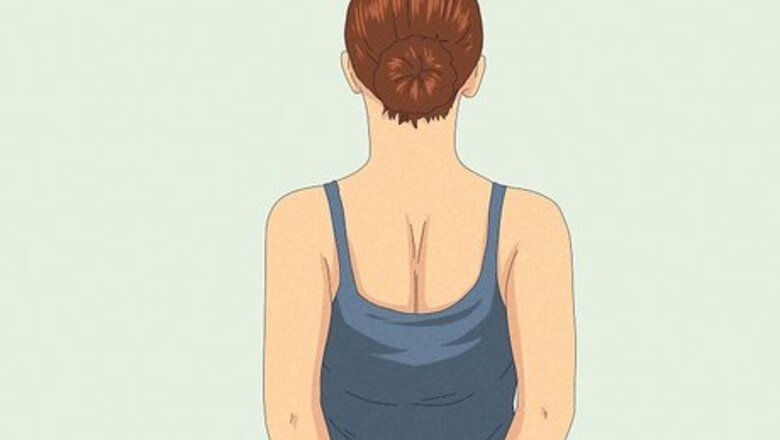
views
- Strengthen your shoulder muscles with exercises like squeezing your shoulder blades together, doing wall push-ups, or performing resistance band workouts.
- Stretch out your back, shoulders, and neck to relieve tension and loosen knots in your muscles that are making you slouch forward.
- Check your posture in a mirror frequently. Roll your shoulders back so they’re relaxed and keep your back and neck straight.
Exercises

Scapular retractions Start by standing up tall with your back straight and your arms at your side. Then, flex your muscles to move your shoulder blades closer together, as if you were trying to hold a pencil between them. Hold your position for about 10 seconds before you relax. Do 5 reps about 2–3 times throughout the day to help your rounded shoulders. Scapular retractions help strengthen your back, neck, and shoulder muscles so you’re less likely to slouch forward.
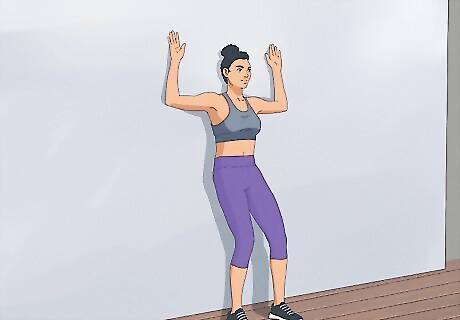
Wall slides Rest your back against a wall and place your heels about 1 foot (30 cm) away from it. Keep the palms of your hands on the wall, and tuck your chin back so your neck is straight. Engage your core muscles and slowly slide your back down the wall until you’re in a sitting position. Then, straighten your legs to get back to your starting position. Do 10 reps once or twice a day. Wall slides make you straighten your back so your shoulders stay in the proper posture. Try raising your arms above your head or bending your elbows at a 90-degree angle to hit different parts of your shoulder muscle.
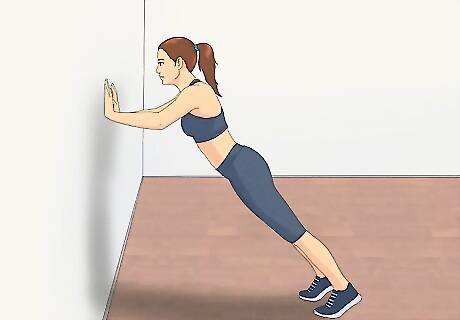
Wall push-ups Face a wall with your feet shoulder-width apart and stretch your arms straight out in front of you so your palms are flat on the surface. Slowly bend your elbows to move your torso closer to the wall. When your elbows make 90-degree angles, push yourself back into your starting position. Complete 2–3 sets that are each 10 reps when you do wall push-ups. Wall push-ups build up your chest muscles so your shoulders aren’t rounded or drooping forward. As wall push-ups get easier, try doing 20 reps per set or standing further out from the wall to increase the difficulty.

Floor angels Lay out a yoga mat and lie flat on your stomach with your arms straight out in front of your head. Activate your core to lift your arms, shoulders, and feet off the ground. Keep your head and neck in line with your spine and look straight down at the floor. Then, pull your arms down so your elbows bend to 90-degree angles. At the end of your motion, try to pinch your shoulder blades together. After that, straighten your arms back to your starting position. Aim to do about 2–3 sets that are each 10 reps. Floor angels work your lats and your traps to help you maintain a better posture. If doing floor angels is too difficult, try doing them against the wall instead. Stand with your back against the wall and your arms straight above your head. Keep the backs of your hands against the wall, and slowly lower your arms until your elbows make a W-shape.
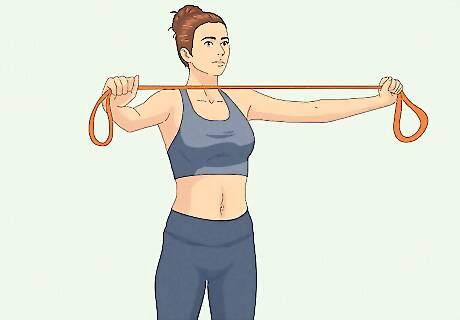
Band pull apart Keep your elbows at your side and bent at 90-degree angles so your forearms stretch out in front of you. Hold one end of a resistance band in each hand so your palms are face-down. When you’re ready to start, move your hands away from each other to stretch the band. Keep your elbows at your sides and pull the band as far as you comfortably can. Hold the position for 1 count before relaxing again. Do 3 sets that are each 15 reps. The resistance band strengthens your chest muscles to help fix any imbalances causing bad posture and rounded shoulders. Use a resistance band that has a lower resistance if you’re just starting off. Otherwise, it might be too difficult to complete all of your reps.
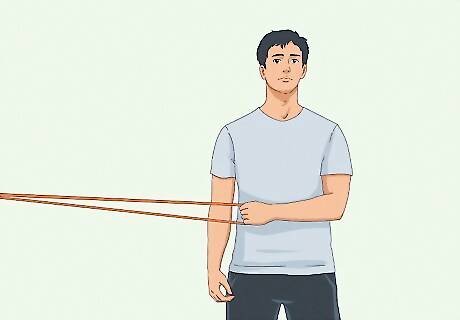
External band rotations Put one end of a resistance band against your door frame just above waist height, and close the door so it doesn’t move around. Stand so your left shoulder faces the door frame and you’re holding the other end of the resistance band in your right hand. Keep your elbow against the side of your body, and pull the band further away from the door. Slowly go back to your starting position. Complete 2–3 sets of 10–15 reps for each shoulder. If you can’t secure a resistance band between your door and the frame, then you can tie it to a railing or banister instead. Band rotations help you build your shoulder and chest muscles so you’re less likely to slouch forward. Esther Gokhale Esther Gokhale, Posture Alignment Specialist Rounded shoulders result from poor posture habits over time. Quick fixes like shoulder rolls may provide temporary relief, but retraining your body for proper alignment is key. Practice the 8 Steps: chin tucked, chest lifted, shoulder blades squeezed, arms rotated externally, spine elongated, pelvis neutral, knees straight, and feet grounded. Do this mindfulness sequence daily until it becomes second nature.
Stretches
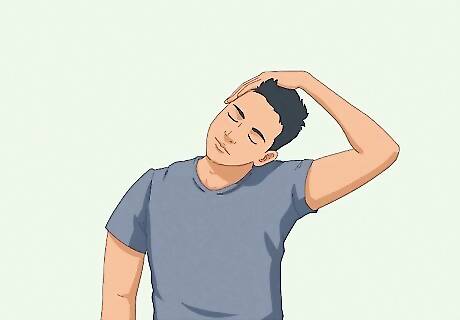
Lateral neck flexion Start by slowly tilting your head to the right like you’re trying to touch your ear to your shoulder. Then, hold onto the side of your head and gently push it to the side to deepen the stretch. Hold the position for about 30 seconds before repeating the stretch on your left side. Lateral neck flexions loosen up tight shoulder muscles that could make your shoulders look rounded.
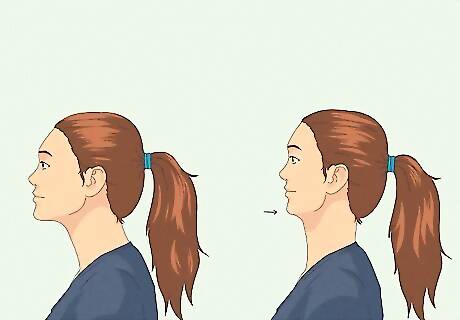
Chin tucks Sit with your back straight in a tall chair and face forward. Move your head backward and pull your chin in toward your neck. Hold your position for 2–3 seconds so you can feel the stretch in the back of your neck. Then, go back to your starting position. Do about 5 reps of this stretch 2–3 times during the day. Chin tucks stretch the muscles in the back of your neck to help prevent slouched shoulders and correct forward head posture.
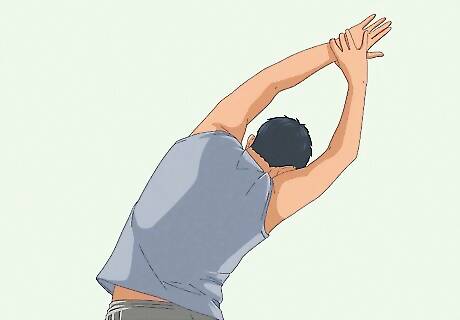
Lat stretch Stand straight up and reach your arms up above your head. Grab onto your right wrist and pull it to the left to stretch your lats on the right side of your body. When you feel slight tension, hold your stretch for 20 seconds before relaxing. Then hold onto your left wrist and pull it to the right to stretch the other side of your body. Stretching your lats helps get rid of any tension in your back so you can improve your posture. If you don’t feel a deep stretch up the side of your body, slightly bend your torso forward while you’re doing it.
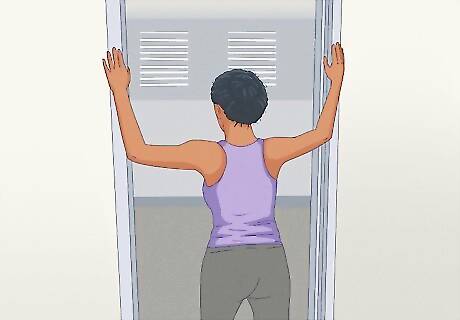
Doorway stretch Bend your elbows to 90-degree angles and stand in an open doorway. Put your forearms straight up against the sides of the door frame. When you’re ready to stretch, take a step forward to stretch your chest and shoulders. Hold the position for about 20 seconds and then relax for a few seconds. A doorway stretch opens up your chest muscles so you’re less likely to slouch forward. If you want a deeper stretch, then take a bigger step forward. Just be sure to ease up if you start feeling any severe pain or discomfort. If you don’t have an open doorway available, you can do the same stretch in a corner. Just put your arms against the walls and lean into the corner to feel the stretch.
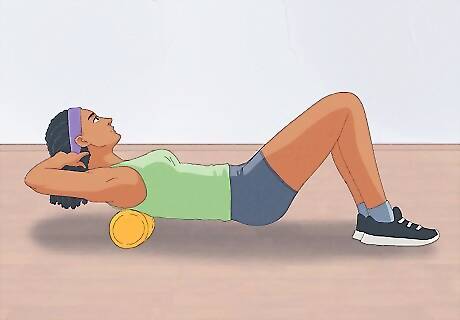
Foam roller release Lie on a foam roller so it’s in line with your spine. Slowly wiggle your body from side to side so the foam roller can release any tight muscles in your back. Then, put your arms straight out past your head. Bend your elbows so your arms make a W-shape to help relax your shoulder muscles too. Hold your position on the foam roller for 30–60 seconds before sitting up again. Foam rolling your back helps loosen tight muscles so you’re able to relax and maintain good posture. Try using a foam roller by laying it parallel with your shoulders and rolling it down the length of your back.
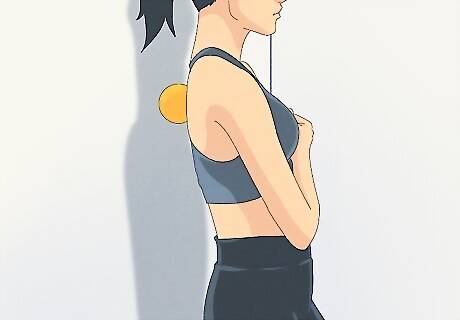
Tennis ball massage If you feel a tight knot on your pecs or back, press a tennis ball against your muscle. Either lie on top of the tennis ball or push it against the wall with your body until you feel slight tension. Roll the tennis ball over your muscle to help break apart the tightness. A tennis ball makes it a lot easier to deeply massage your muscles so your chest and back aren’t so tight. If you don’t have a tennis ball, you can instead use a massage hook to reach and target areas on your back and neck.
Improving Posture
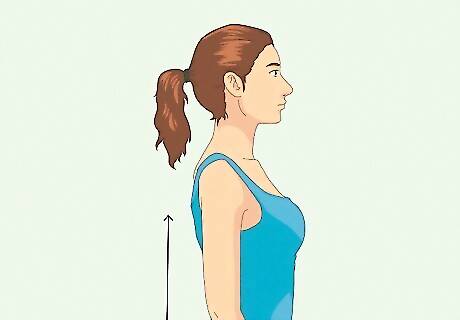
Keep your back straight and shoulders back. Whether you’re standing or sitting, straighten out your back and roll your shoulders back to keep them relaxed. Push your head back so your neck is in line with the rest of your spine. Whenever you notice that you don’t have a perfect posture, take a few seconds to readjust so you can get comfortable again. Try setting a timer every 30 minutes and checking your posture when it goes off. That way, it’ll be a lot easier to recognize when your shoulders are slouching. Try to distribute your weight evenly between both legs so you don’t favor one side over the other.

Use your phone or computer at your eye level. When you bend your neck down to check your phone or look at a laptop screen, it may make your shoulders roll forward too. If you’re looking at your phone, raise it higher up so you don’t have to bend your neck to look at it. If you’re working at a computer, try to keep the top of the screen at your eye level so you aren’t craning your neck or slouching your shoulders.
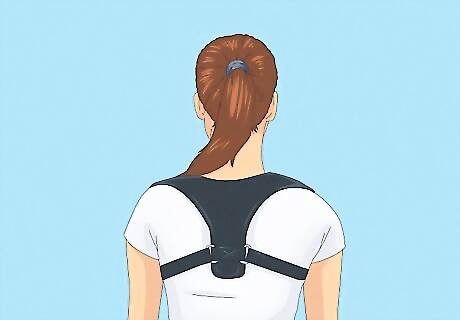
Wear a posture corrector to train your body. A posture corrector is a brace you wear on around your shoulders to help you hold your shoulders and back in the proper position. Slip the brace onto each arm and slide it up so it pulls the fronts of your shoulders back. Wear the brace for 1–2 hours at a time, and then take it off and practice holding the posture on your own. Wearing or relying on a posture corrector for long periods of time can actually weaken your muscles and make rounded shoulders worse.
Causes

Poor posture When you slouch forward while you’re standing or sitting, the muscles in the front of your body tighten up and make your shoulders roll forward. If you’re always bending your neck down, pointing your chin, or slouching your back, then you’re more likely to develop rounded shoulders. You can test your posture by standing with your back against a wall and your feet 6 inches (15 cm) away. If you have correct posture, the back of your head and your shoulder blades will touch the wall.
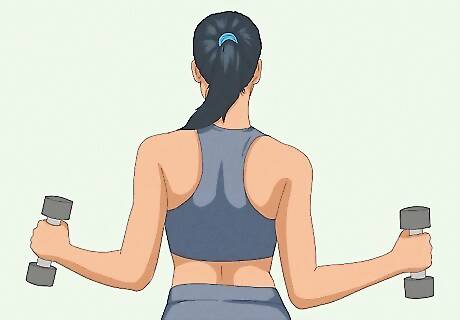
Muscle imbalances If you primarily focus on chest exercises, then your back muscles aren’t strong enough to hold your shoulders back in the proper position.. Rather than focusing only on one muscle group, try to work out your chest, shoulders, and back evenly so they all stay balanced.
















Comments
0 comment